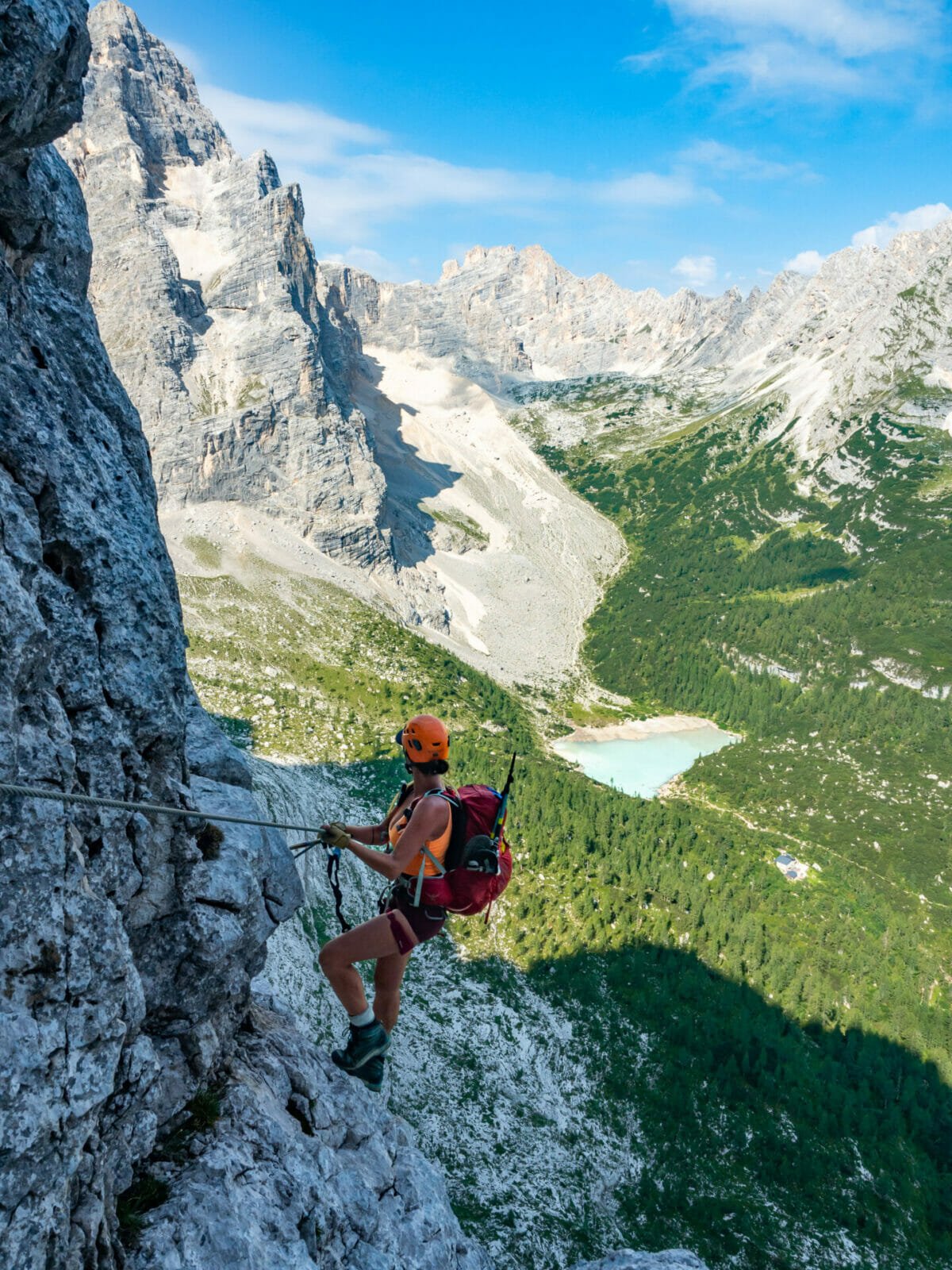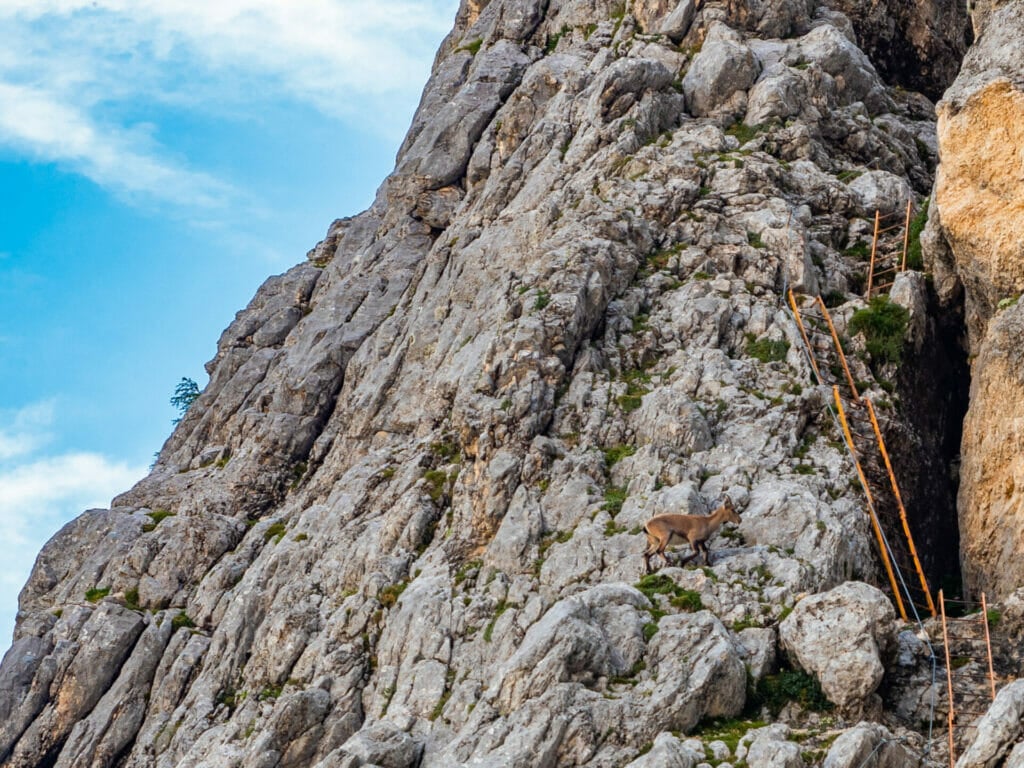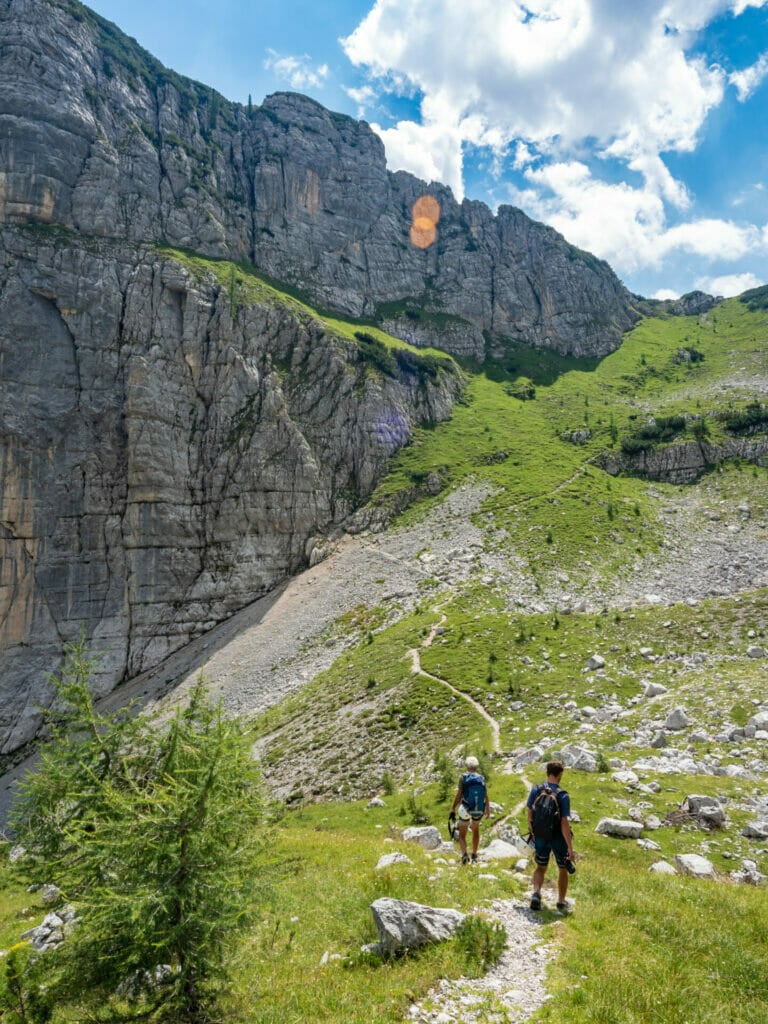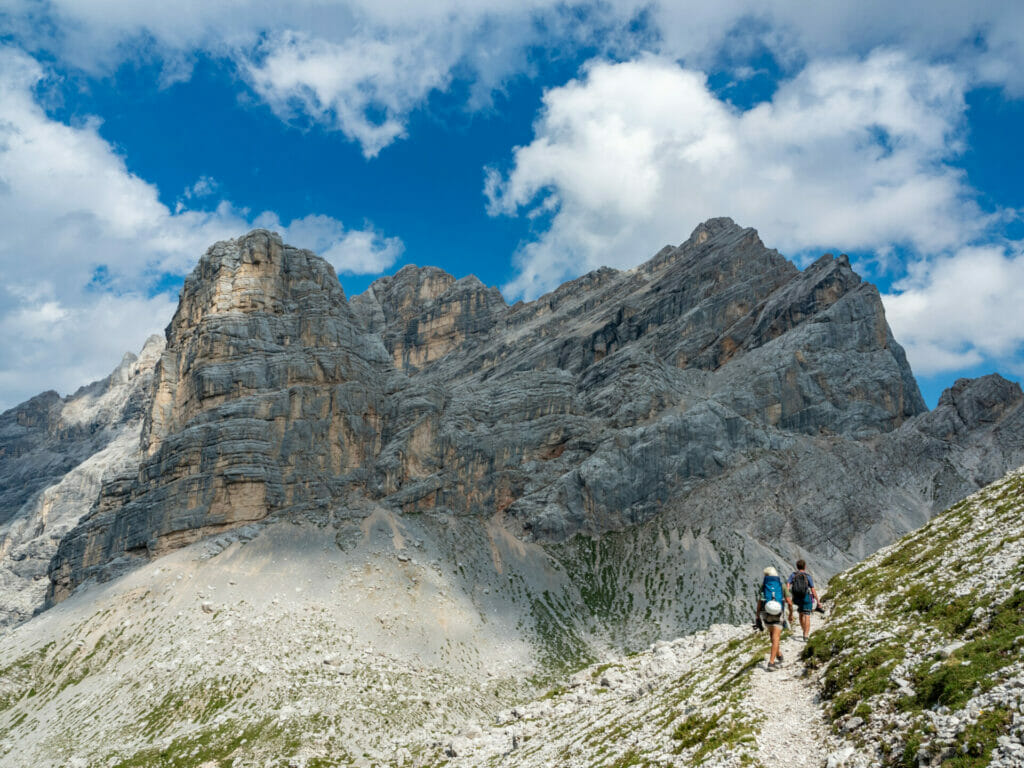
Alta Via 4 (day 4): Rifugio Vandelli to Rifugio San Marco + Via Ferrata Giro di Sorapis
Last Updated on 22 April 2025
Today’s route is dominated by a long and exhilarating via ferrata, two-thirds of the epic Giro di Sorapis that circumnavigates a dramatic peak of the same name. This is the most challenging of AV4’s unavoidable via ferrata, and together with tomorrow’s route over Forcella del Ghiacciaio, it is also the wildest terrain you’ll encounter on all of Alta Via 4, with rough trails increasing the navigational demands and frequent exposure necessitating careful footwork.
From the milky blue shores of Lago di Sorapis to the lofty heights reached on Via Ferrata Alfonso Vandelli, the most thrilling section of climbing, you’re unlikely to see many (if any) other hikers, a welcome respite from yesterday’s crowded trail!
This comprehensive guide to Day 4 of Alta Via 4 contains detailed section times, route recommendations, adventurous side trips, via ferrata, and heaps of insider tips— use it to plan your hike & then refer back on the trail so you always know what to expect!
All my AV4 knowledge in one place: Alta Via 4: complete hiking + via ferrata route guide
Alta Via 4: Day 4 overview
- Trail hours: 6.25hrs
- Distance: 11km
- Elevation gain & loss: 1530m up & 1630m down
- Via Ferrate en route: Giro di Sorapis (Via Ferrata Alfonso Vandelli & Sentiero Carlo Minazio; loop; 3C)— refer to Tabacco Map 003 & Cicerone Vol.1 (route 59)
- Huts: Rifugio San Marco, (Rifugio Galassi— 45min)

Rifugio Vandelli to Via Ferrata Alfonso Vandelli (3B; 1.5hrs)
After swinging once more by Lago di Sorapis (just a few minutes away from Rifugio Vandelli) and enjoying the incredible views without the crowds that will be arriving soon enough, ascend through bushes and scrub above/left of the lake to connect with AV4.
Following cairns across enormous limestone slabs for another 15min, you’ll eventually reach western side of Croda del Fogo and the start of Via Ferrata Alfonso Vandelli, marked by a metal plaque. A long string of continuous metal ladders lead steadily up the rock face in front of you, an exhilarating vertical climb that offers soaring views over the turquoise waters of Lago di Sorapis and the dramatic glacial basin of Tondi di Sorapis.
If you’re following my custom AV4 adventure route, the best way to stay on track is with my custom-built AV4 GPS map— packed with detailed daily tracks, 98+ waypoints, all the side trips & via ferrata described in this guide, plus extensive trail notes to help you navigate AV4 like an expert.
Available in both JSON and GPX formats, the map works seamlessly with GPS apps like CalTopo, Gaia, and AllTrails, or with Garmin devices and watches. Head to my storefront to purchase the map!

Via Ferrata Alfonso Vandelli is a wonderful and occasionally challenging route that climbs the rock on ladders, pegs, and a good deal of natural holds. There’s a bit of unprotected scrambling (as well as spots where clipping to the cable is actually harder than just ascending solo) mixed throughout and I particularly relished in the exposed ledges that offered the best views outward towards Monte Cristallo. Allow around 1hr to top out on a high point.
It should also be noted that this is the most demanding of AV4’s unavoidable en-route via ferrata, rated a 3 (out of 5) in difficulty and maintaining constant and often extreme exposure. This is where a head for heights and steady footwork is really required, so take your time.
New to via ferrata? Read this post: Introduction to via ferrata + complete via ferrata gear list



Sentiero Carlo Minazio to Forcella Grande (1B; 4hrs)
Once off the main via ferrata and onto the much simpler (and thinly cabled) Sentiero Carlo Minazio, descend for about an hour to Bivacco Comici— an improbably small backcountry structure that sleeps 9 in the middle of a grassy gully. This is an ideal spot for a snack break!


The route descends only a few moments beyond the bivouac before commencing a steep climb for about 10min up the opposite grassy slope. This is the first, and perhaps the most sustained, in a series of steep bursts that lead you up and down over the rugged terrain of Giro di Sorapis to reach Forcella Grande.
These quiet meadows are covered with wildflowers, including edelweiss, an enduring symbol of the Alps that has come to represent resilience— this small white mountain flower thrives in harsh alpine conditions, and although it was threatened in past years, a valiant restoration project (that includes a ban on picking the flower) has restored it to prominence across the Italian, Austrian, Swiss, and German Alps.
Also common to spot in the shrub beneath Forcella Grande are alpine ibex, a type of athletic mountain goat with long curved horns (which you may also have noticed in the earlier morning around Logi di Sorapis or along Via Ferrata Alfonso Vandelli, as in one of my photos above!). They seem to love both the rocky terrain earlier in the day and the verdant meadows here, but I suspect it is equally the lack of people that draws them to this area! Keep your eyes open for exciting flora and fauna sightings.



The constant ascending/descending levels out around a trail junction, with one possible (shorter but far harder) route dropping down the valley and the preferred route contouring gently around the hillside on path 247 all the way to Forcella Grande at 2,255m, visible at the top of the valley.

Forcella Grande to Rifugio San Marco (45min)
From the pass, the route drops steeply on a rocky trail to the garden paradise of Rifugio San Marco. The large steps and rough terrain are hard on the knees, but thankfully short enough to avoid major discomfort as you descend into the idyllic shadow of Antelao and Sorapis, seemingly close enough to reach out and brush your hand against the rocky face of Cima Belprà.
For all the previous day’s activity, San Marco is a refuge tucked away in the quietest of corners of the eastern Dolomites and a truly special experience.

Night 4: Rifugio San Marco
Quaint gardens surround family-owned Rifugio San Marco, with spectacular sun dappled views of Mount Pelmo providing an afternoon welcome. This is one of the few huts in the Dolomites that has maintained its original structure since it was first built by the Club Alpino Italiano in 1895, and walking through the peaceful grounds and simple dining room truly feels like stepping back in time.
Flower-filled baskets adorn the stone exterior, lace curtains hang in every window, and life just moves a little slower at San Marco. Facilities are basic but very comfortable; this is a real gem of a hut! Reserve Rifugio San Marco by emailing info@rifugiosanmarco.com.
- Rooms: 30€ (small room) OR 68€ half board (small room)
- Food: simple but delicious dinner, very scant breakfast; beer and wine available for purchase
- Showers: outdoor solar shower, arrive early if you want to use this!
- Connectivity: strong mobile signal
- Alpine club discount: -14.5€ room only OR 9€ half board
For more information on what to expect in a mountain hut & how to prepare for your stay: Everything you need to know about mountain huts (rifugi) in the Italian Dolomites


Read more about Alta Via 4
- start here ->Detailed AV4 Route Guide
- ALTA VIA 4 (DAY 0): SAN CANDIDO TO RIFUGIO TRE SCARPERI
- ALTA VIA 4 (DAY 1): RIFUGIO TRE SCARPERI TO LOCATELLI TRE CIME + VIA FERRATA TORRE DI TOBLIN & INNERKOFLER
- ALTA VIA 4 (DAY 2): RIFUGIO LOCATELLI TRE CIME TO RIFUGIO FONDA SAVIO + VIA FERRATA MERLONE
- ALTA VIA 4 (DAY 3): RIFUGIO FONDA SAVIO TO RIFUGIO VANDELLI
- ALTA VIA 4 (DAY 4): RIFUGIO VANDELLI TO RIFUGIO SAN MARCO + VIA FERRATA GIRO DE SORAPIS
- ALTA VIA 4 (DAYS 5 & 6): RIFUGIO SAN MARCO TO RIFUGIO ANTELAO TO PIEVE DI CADORE
- navigate confidently on & off the trail ->AV4 adventure route GPS map!

The Comments
midlaj
It sounds like Day 4 of the Alta Via 4 will be an exciting and adventurous day with a via ferrata and a scenic route around the Sorapis peak. The detailed information provided in your guide, including section times, route recommendations, and insider tips, will be incredibly valuable for hikers planning to undertake this challenging hike. The mention of fewer crowds compared to the previous day adds to the appeal of this section, making it an ideal choice for those seeking a more serene and immersive experience in nature. It’s always wise to be well-prepared and informed when embarking on such adventures, and your guide appears to provide just that.